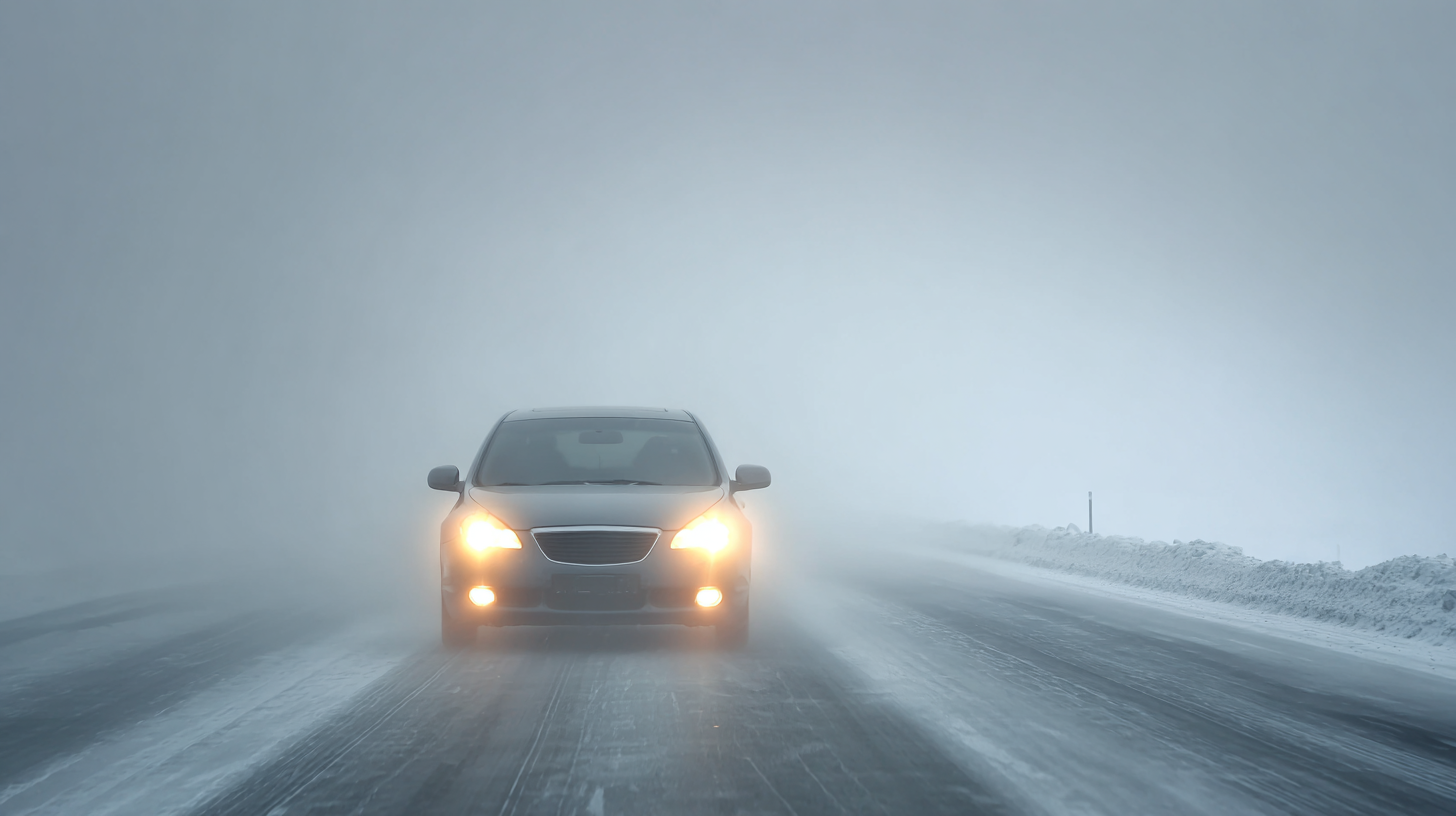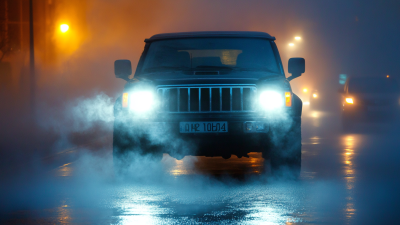In the realm of automotive safety, the importance of clear visibility in adverse weather conditions cannot be overstated. According to the National Highway Traffic Safety Administration (NHTSA), over 20% of all vehicle accidents occur during inclement weather, with fog, rain, and snow being significant contributing factors.
 Fog lights play a crucial role in enhancing visibility by illuminating the road immediately ahead while reducing the amount of light that reflects off the fog, rain, or snow. Studies indicate that vehicles equipped with fog lights have a 50% higher rate of avoiding accidents in low-visibility scenarios compared to those without them. As driving conditions can change rapidly, understanding the benefits of fog lights is essential for drivers seeking to maximize safety and maintain clarity on the road.
Fog lights play a crucial role in enhancing visibility by illuminating the road immediately ahead while reducing the amount of light that reflects off the fog, rain, or snow. Studies indicate that vehicles equipped with fog lights have a 50% higher rate of avoiding accidents in low-visibility scenarios compared to those without them. As driving conditions can change rapidly, understanding the benefits of fog lights is essential for drivers seeking to maximize safety and maintain clarity on the road.
Fog lights play a crucial role in enhancing road safety during challenging weather conditions. Unlike standard headlights, fog lights are designed to illuminate the road immediately in front of the vehicle, providing better visibility in fog, rain, or snow. This low, wide beam of light reduces the amount of light that is reflected off the fog, ensuring that drivers can see the road clearly without being blinded by the light bouncing back at them. By improving visibility at close range, fog lights help drivers navigate tricky situations more effectively, reducing the risk of accidents.
Moreover, the use of fog lights not only benefits the driver but also enhances safety for other road users. When fog lights are activated in poor visibility conditions, they signal to other drivers that a vehicle is present, which is especially important on dimly lit roads. This increased awareness can help prevent collisions and contribute to a safer driving environment for everyone. In summary, the importance of fog lights cannot be overstated, as they serve as a vital tool for enhancing visibility and safety on the road during inclement weather.
Fog lights play a critical role in enhancing visibility during challenging weather conditions, especially in fog, rain, and snow. Unlike standard headlights, which can reflect off fog and create a wall of glare, fog lights are specifically designed to illuminate the road immediately in front of a vehicle. Their low beam pattern casts light horizontally, allowing drivers to see hazards, road markings, and other vehicles more clearly in poor visibility situations. This design not only improves safety but also encourages adherence to speed regulations; for instance, recent measures to reduce speed limits in areas like Yamuna Expressway highlight the need for improved visibility as weather conditions deteriorate.
Recent trends in automotive lighting indicate a shift towards advanced technologies such as LED fog lights, which not only provide enhanced illumination but also offer greater energy efficiency. The automotive lighting market is projected to reach $58.8 billion from 2025 to 2033, driven by innovations in lighting technology and an increasing demand for electric vehicles. Research shows that vehicles equipped with high-quality fog lights have been proven to significantly reduce accident rates in low-visibility conditions, underscoring the importance of investing in these essential safety features. Whether for personal driving or commercial trucking, the right fog lights can make all the difference in ensuring safe navigation through the fog.
 Fog lights serve as a critical enhancement to vehicle safety, especially in adverse weather conditions. Unlike standard headlights, which are designed to illuminate the road ahead, fog lights provide a wider and shorter beam of light that is particularly effective in heavy fog, rain, or snow. According to the National Highway Traffic Safety Administration (NHTSA), reduced visibility conditions can increase accident risk by 30%. Fog lights help to mitigate this risk by illuminating the ground directly in front of the vehicle, reducing the glare that can come from standard headlights reflecting off fog or rain droplets.
Fog lights serve as a critical enhancement to vehicle safety, especially in adverse weather conditions. Unlike standard headlights, which are designed to illuminate the road ahead, fog lights provide a wider and shorter beam of light that is particularly effective in heavy fog, rain, or snow. According to the National Highway Traffic Safety Administration (NHTSA), reduced visibility conditions can increase accident risk by 30%. Fog lights help to mitigate this risk by illuminating the ground directly in front of the vehicle, reducing the glare that can come from standard headlights reflecting off fog or rain droplets.
In a comparative analysis, vehicles equipped with fog lights can significantly improve driver awareness and response times. A study by the Society of Automotive Engineers (SAE) indicated that using fog lights during heavy precipitation decreased the likelihood of accidents by up to 25%. This demonstrates how investing in proper fog lighting not only enhances visibility for the driver but also aids other road users in recognizing a vehicle in challenging weather. With the growing concern over weather-related incidents on the roads, integrating fog lights can be viewed as a responsible safety measure for both personal and public vehicles.
When selecting fog lights for your vehicle, it’s crucial to consider factors such as brightness, beam pattern, and color temperature. According to the National Highway Traffic Safety Administration (NHTSA), well-designed fog lights dramatically improve visibility in adverse weather conditions, reducing the risk of accidents. For instance, choosing lights with a color temperature around 3000K can enhance contrast in fog, rain, or snow, effectively piercing through moisture and enhancing road visibility.
Another essential aspect is the beam pattern; a wider, lower beam is effective in minimizing the amount of light that reflects off the fog or rain, which is critical in maintaining driver visibility. The Automotive Aftermarket Industry Association (AAIA) reports that vehicles equipped with quality fog lights can see up to 60% better in such conditions compared to those relying solely on standard headlights. When choosing fog lights, look for models that offer adjustable mounting options and are made from durable materials to withstand varying weather conditions, ensuring longevity and reliability while enhancing your driving safety.

Proper maintenance of fog lights is essential for achieving optimal performance, especially in challenging weather conditions. Regularly inspecting fog lights for any signs of damage or wear is crucial. Check for cracks in the lens, which can allow moisture to enter, leading to reduced illumination. Additionally, ensure that the bulbs are functioning correctly and replace them promptly if they flicker or fail. This proactive approach not only enhances visibility but also increases safety on the road.
Another vital aspect of maintenance involves cleaning the fog light lenses. Over time, dirt, grime, and road debris can accumulate, diminishing the effectiveness of the lights. Using a gentle cleanser and microfiber cloth can restore clarity, ensuring that fog lights illuminate the road effectively. Furthermore, checking the alignment of the fog lights is important; misaligned lights can lead to glare that distracts other drivers rather than providing the intended illumination. By implementing these best practices, drivers can ensure their fog lights operate at peak efficiency, enhancing both safety and visibility in adverse weather conditions.






